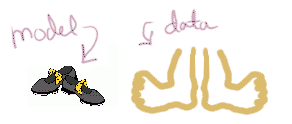Detour Stop 1: What's a p-value?
 If your shoes don't fit a little, they might cause a little pain, but not enough to pay attention to. But somewhere there's a threshold. If the shoe is too small, you go out and buy new ones.
If your shoes don't fit a little, they might cause a little pain, but not enough to pay attention to. But somewhere there's a threshold. If the shoe is too small, you go out and buy new ones.
 Something similar happens with statistical tests such as the chi-square. If your calculated statistic value (i.e., the chi-square-calc) is a "little bit" big, that's not enough to contradict your hypothesis. But if its a LOT too big, then it does matter -- it is "significant".
Something similar happens with statistical tests such as the chi-square. If your calculated statistic value (i.e., the chi-square-calc) is a "little bit" big, that's not enough to contradict your hypothesis. But if its a LOT too big, then it does matter -- it is "significant".
I know this is still rather vague, so hang on. Statisticians measure how significant the calculated value is using what they call a "p-value" (p stands for "probability", not "pain"). A big p-value means that the calculated value could "probably" have happened by chance process -- like a little random slop. A small p-value means there's only a small probability that the calculated value arose from a little random slop. A p-value of 0.05 means essentially only 5% similar calculated values come from "sloppy" data, and the rest are "significant". In fact, this is the famous p=0.05 threshold that most scientists use (well, not famous like American Idol, but trust me, famous among statisticians and scientists).
Copyright University of Maryland, 2007
You may link to this site for educational purposes.
Please do not copy without permission
requests/questions/feedback email: mathbench@umd.edu